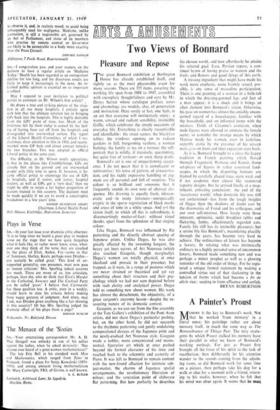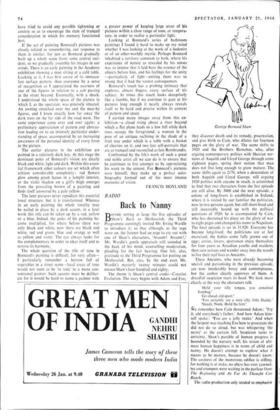A Painter's Proust
MEMORY is the key to Bonnard's work. Not that he worked 'from memory' in a literal sense; his paintings rather are about memory itself, in much the same way as The Remembrance of Things Past. The very strata- gems by which Proust stalked his memory have their parallel in what we know of Bonnard's working methods. For just as Proust first brought all the force of his spirit to the task of recollection, then deliberately let his attention wander to the sounds coming from the adjoin- ing room, so did Bonnard work for some time on a pioture, then perhaps take his dog for a walk or chat for a moment with a friend, return- ing to his studio, however, when he felt that his mind was clear again. It seems that he must
have tried to avoid any possible tightening or anxiety so as to encourage the state of tranquil concentration in which his memory functioned best.
If the act of painting Bonnard's pictures was closely related to remembering, our response to them is similar; for just as Bonnard gradually built up a whole scene from some central inci- dent, so we gradually assemble his images in our minds. There is an early painting in the Academy exhibition showing a man sitting at a café table. Looking at it, I was first aware of its immacu- late surface pattern; then overcome by a sense of recognition as I appreciated the nearness of one of the figures in relation to a cab passing in the street beyond. Eventually, with a shock, I understood the whole space of the picture in which I, as the spectator, was precisely situated. An awning stretched over me and the near-by figures, and I knew exactly how far away the dark trees on the far side of the road were. The same experience came over and over again: a preliminary appreciation of pattern and abstrac- tion leading on to an intensely particular under- standing of space, accompanied by an increasing awareness of the personal identity of every form in the picture.
The earlier pictures in the exhibition are painted in a relatively dark key. At this stage the dominant poles of Bonnard's vision are clearly black and white, light and dark. Within this essen- tial framework other colours are set which often achieve considerable complexity: red flowers glow among green leaves in a lamplit interior, or the violet shadow on a girl's thigh emerges from the prevailing brown of a painting and finds itself answered by a pale yellow.
The later pictures never repudiate this essential tonal structure, but it is transformed. Whereas in an early painting the whole tonality may be nailed in place by a dark accent, in a later work this role can be taken up by a red, yellow or a blue. Indeed, the poles of his painting be- come multiplied, for where before there was only black and white, now there are black and white, red and green, blue and orange as well as yellow and violet. The eye always looks for the complementary in order to clear itself and to restore its harmony.
The whole question of the role of tone in Bonnard's painting is difficult, for very often— I particularly remember a barrow full of vegetables in a street scene—local areas of tone would not seem to be `in tone' to a more con- ventional painter. Such accents must be deliber- ate for it would be hard to name a painter with a greater power of keeping large areas of his pictures within a close range of tone, or tempera- ture, in order to realise a particular light.
Looking at Bonnard's series of bathroom paintings I found it hard to make up my mind whether I was looking at the work of a hedonist or of an other-worldly mystic. Perhaps Bonnard inhabited a territory common to both, where his experience of nature as revealed by his senses was so intense that it laid bare the essence of the objects before him, and his feelings for the unity —particularly of light—uniting them was so strong that it had the vastest consequences.
Bonnard's touch has a probing intimacy that explores, almost fingers, every surface of his subject. At times this touch looks deceptively like a fumble, but if we continue to gaze at his pictures long enough it nearly always reveals itself to be hard and precise within its context of pattern and space.
I carried many images away from this ex- hibition—a cloud rising above a river beyond which a flat plane leads to a low hill while dark trees occupy the foreground; a woman in the pose of an antique reclining in the shade of a fruit tree under which is a table with a basket of cherries on it; and two late self-portraits that are as tranquil and reconciled as late Rembrandts.
Confronted by the life's work of such a great and noble artist all we can do is to ensure that he continues to live amongst us by appreciating his work to the utmost. For Bonnard's pictures were himself, they make up a perfect auto- biography formed out of his most intense moments of vision.
FRANCIS HOYLAND



































 Previous page
Previous page